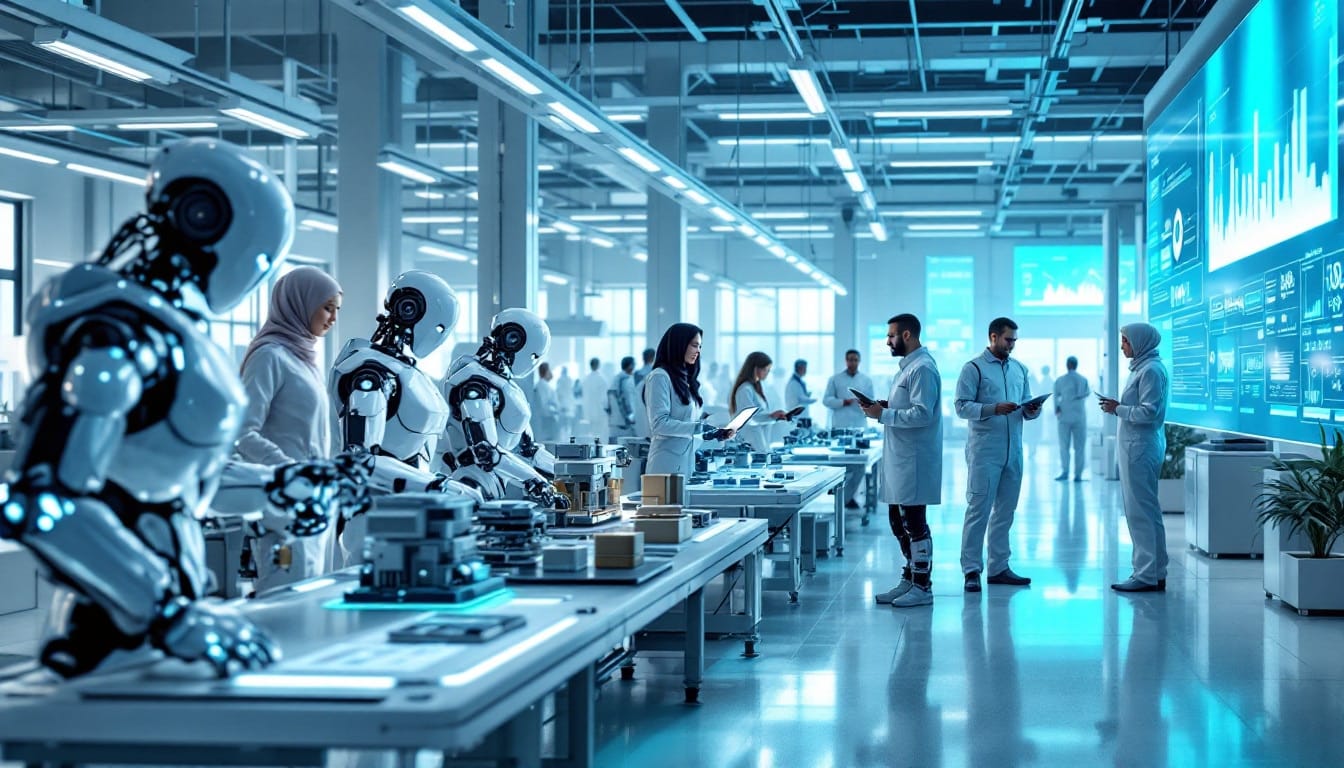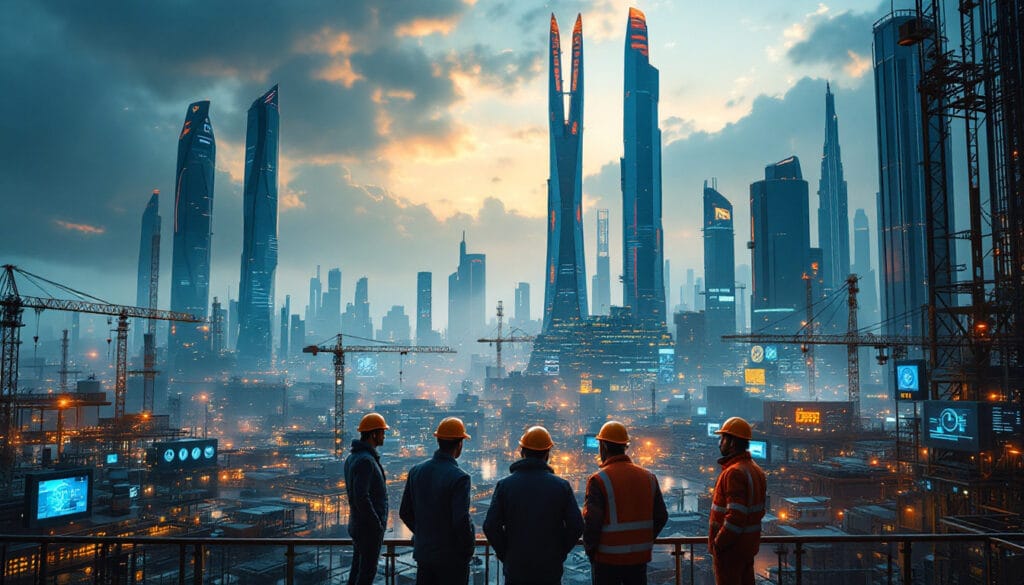Industry 5.0 redefines the contours of modern production, placing humans at the heart of digital transformation. In Europe, this transformational vision promises to make supply chains more sustainable and resilient. This new industrial era seamlessly integrates advanced technology and worker well-being.
Industry 5.0 offers an unprecedented balance between technological innovation and social responsibility, paving the way for ethical and environmentally friendly production. Companies adopt sustainable practices while maximizing process efficiency through Artificial Intelligence and collaborative robotics. This transition fosters better adaptability to contemporary challenges and sets the stage for a thriving circular economy. Thus, Industry 5.0 stands out as an essential lever for a competitive and eco-responsible Europe.
Table des matières
ToggleWhat is Industry 5.0 and how does it differ from Industry 4.0?
Industry 5.0 represents a significant evolution compared to Industry 4.0, emphasizing not only digital transformation and automation but also close collaboration between humans and machines. While Industry 4.0 focused on the integration of technologies such as the Internet of Things (IoT), artificial intelligence (AI), and robotics to optimize production processes, Industry 5.0 goes further by reintroducing the human element as a central pillar.
This new approach aims to create more sustainable and socially responsible work environments, where advanced technologies are utilized to enhance worker well-being and strengthen the resilience of supply chains. For example, while Industry 4.0 allows for ultra-efficient production, Industry 5.0 ensures that this efficiency does not come at the expense of working conditions or environmental impact.
A recent report from the European Commission on Industry 5.0 highlights this orientation towards a more sustainable and human-centered industry. This report recognizes the modern industry’s ability to achieve societal goals while respecting the environment. Industry 5.0 places the well-being of workers at the heart of the production process, thus promoting a harmonization between technological progress and social responsibility.
In summary, Industry 5.0 is not merely about pursuing the technological advancements of Industry 4.0 but integrates them into a more holistic and humanistic vision of industrial production. This transition marks a paradigm shift, where technological innovation also serves social and environmental goals, thereby creating an industry that is both efficient and ethical.
What are the advantages of Industry 5.0 for your business?
Adopting Industry 5.0 brings numerous advantages for businesses, going beyond operational efficiency to include human and sustainable aspects. One of the main advantages lies in the improvement of employees’ quality of life. By integrating advanced technologies such as collaborative AI and smart robots, companies can automate repetitive and dangerous tasks, allowing workers to focus on higher value-added activities.
Furthermore, Industry 5.0 promotes a more flexible and responsive production to changing market needs. Smart Factory systems become more adaptive, thanks to the integration of technologies like digital twins and augmented reality. These innovations enable more effective production planning and task allocation, while reducing lead times and costs.
Another key advantage is sustainability. Industry 5.0 encourages the adoption of eco-friendly practices, reducing the carbon footprint of operations and promoting responsible resource management. This focus on sustainability is not only beneficial for the environment but also enhances the company’s reputation among consumers and business partners sensitive to ecological issues.
Moreover, Industry 5.0 strengthens the resilience of supply chains. By integrating advanced technologies and fostering collaboration among stakeholders, companies can better anticipate and manage disruptions, whether they arise from economic, technological, or natural sources. This resilience is essential in a context of increasing globalization and frequent disruptions.
A concrete example of this approach is the adoption of collaborative AI and robots by French companies, as mentioned in the article on Industry 5.0. These technologies not only boost productivity but also create a safer and more pleasant working environment for employees.
Finally, Industry 5.0 provides a competitive advantage by enabling companies to innovate more quickly and respond more effectively to market needs. By combining technology and humanity, companies can develop more tailored and personalized products and services, thereby strengthening their market position.
What challenges might your company encounter during the transition?
The transition to Industry 5.0, while promising, is not without challenges. One of the main obstacles lies in the initial investment needed to adopt new technologies. The implementation of advanced systems such as artificial intelligence, collaborative robots, and digital twins requires financial resources and technical skills that not all companies possess immediately.
Another major challenge concerns change management within the organization. The introduction of new technologies transforms not only production processes but also corporate culture. It is essential to train employees in the new required skills and involve them in the transformation process to avoid resistance to change and ensure a smooth adoption of new practices.
Data security is also a crucial issue. With the increased integration of AI and IoT, companies must enhance their cybersecurity measures to protect sensitive information from cyberattacks. Data protection thus becomes a top priority, requiring continuous investment in security technologies and staff training.
Additionally, the transition to Industry 5.0 can pose ethical and social challenges. The increased use of AI and robots raises questions about the potential loss of jobs and the impact on worker well-being. Companies must find a balance between automation and job preservation, ensuring that technologies are used to improve working conditions rather than deteriorate them.
Collaboration with external partners is also essential but can be complex to manage. Industry 5.0 relies on an interconnected network of companies, suppliers, and customers. Ensuring effective communication and optimal coordination among these different actors can represent a significant logistical and organizational challenge.
Finally, regulation and compliance can hinder the adoption of Industry 5.0. Companies must navigate a constantly evolving legal landscape, where rules regarding AI, data protection, and sustainability may vary from one country to another. It is crucial to stay informed of regulatory developments and to ensure that new technologies comply with current standards.
How to prepare your business to adopt Industry 5.0?
To successfully transition to Industry 5.0, companies must adopt a strategic and well-planned approach. Here are some key steps for effective preparation:
1. Assess technological maturity: Start with a thorough analysis of your current technologies and production processes. Identify the areas where improvements are needed and where new technologies can add value.
2. Train and develop skills: Invest in training your employees to master new technologies such as AI, robotics, and advanced management systems. A well-trained workforce is essential to fully leverage the benefits of Industry 5.0.
3. Collaborate with experts: Engage consultants or partners specialized in Industry 5.0 to guide you through the transition process. Their expertise can help you avoid common pitfalls and implement solutions tailored to your specific needs.
4. Invest in cybersecurity: Strengthen your security measures to protect your data and systems against cyber threats. A secure infrastructure is essential to ensure the reliability and continuity of your operations.
5. Adopt a human-centered approach: Integrate social and ethical considerations into your technology adoption strategy. Ensure that technologies are used to enhance employee well-being and foster a positive corporate culture.
6. Establish strategic partnerships: Collaborate with other companies, suppliers, and academic institutions to share knowledge and resources. Partnerships can accelerate innovation and facilitate the adoption of new technologies.
7. Plan a clear roadmap: Define clear objectives and steps for the transition to Industry 5.0. A well-defined roadmap allows you to track progress and adjust strategies based on evolving needs.
An inspiring example can be found in the adoption of collaborative AI by French companies, as described in the article on Industry 5.0. These companies have successfully integrated new technologies while maintaining a human and sustainable work environment.
What are some concrete examples of successful implementation of Industry 5.0?
Several companies around the world have already begun the transition to Industry 5.0, demonstrating the tangible benefits of this innovative approach. A notable example is Lisa Davis, a pioneer of intelligent industry and automation at Siemens USA. Under her leadership, Siemens has integrated advanced technologies such as collaborative robots and intelligent data management systems while placing humans at the center of its production processes.
Another example is that of French companies adopting collaborative AI and robots while integrating sustainable practices for more flexible production. This approach not only increases productivity but also improves working conditions and reduces environmental impact. You can learn more about this transition in the article Towards Industry 5.0.
Honeywell is another relevant example. The company, the last and largest American industrial conglomerate, has recently split into three distinct entities to better position itself in the era of Industry 5.0. This reorganization has allowed for better integration of advanced technologies and a heightened focus on sustainable and human-centered solutions, as detailed in Honeywell splits.
Furthermore, many SMEs have found in Industry 5.0 an opportunity to differentiate themselves. By adopting technologies such as augmented reality for training and maintenance, companies have been able to reduce training costs and improve operational efficiency. The use of digital twins also allows for real-time simulation and optimization of production processes, providing increased flexibility and adaptability to market fluctuations.
These examples demonstrate that Industry 5.0 is not just a futuristic trend but a concrete reality that is already transforming the industrial landscape. By combining advanced technology and a human focus, companies can improve their efficiency and productivity while contributing to more sustainable and socially responsible practices.
What is the importance of innovation and collaboration in Industry 5.0?
Innovation and collaboration are at the heart of Industry 5.0, acting as the main drivers of this revolutionary transformation. Technological innovation, whether it be artificial intelligence, advanced robotics, or digital twins, is essential for developing solutions that optimize production processes while respecting the principles of sustainability and human well-being.
However, innovation cannot occur in isolation. Collaboration among different stakeholders – companies, suppliers, academic institutions, and even competitors – is crucial to share knowledge, resources, and best practices. This synergy helps to overcome technological and organizational challenges, thus facilitating a faster and more effective adoption of new technologies.
A key aspect of this collaboration is the integration of human and technological skills. Industry 5.0 values the role of workers as co-creators with machines, leveraging unique human skills such as creativity, judgment, and empathy. This collaborative approach requires a work environment where technology is viewed as a tool for enhancing human capabilities rather than as a substitute.
Moreover, innovation in Industry 5.0 also includes sustainable and ethical practices. Companies must integrate environmental and social considerations into the development of new technologies, ensuring that technological progress does not come at the expense of the planet or human communities.
A concrete example of this importance of innovation and collaboration is the implementation of collaborative robots in French companies. These robots work alongside humans, improving productivity while creating a safer and more pleasant work environment. This collaboration between humans and machines is made possible by continuous innovation and close collaboration between different departments of the company.
Finally, innovation and collaboration are also essential for meeting the changing expectations of consumers and the market. In a world where demands for customization, sustainability, and social responsibility are increasing, companies must continuously innovate and collaborate with various partners to remain competitive and relevant.
In conclusion, innovation and collaboration are indispensable pillars of Industry 5.0, enabling companies to create sustainable and responsible value. By integrating these elements into their strategy, companies can not only successfully transition to Industry 5.0 but also contribute to a more human and resilient industrial future.
What are the impacts of Industry 5.0 on the supply chain?
Industry 5.0 profoundly transforms the supply chain by introducing advanced technologies and emphasizing resilience and sustainability. One of the main impacts is the optimization of logistical flows through artificial intelligence and machine learning. These technologies enable predictive demand analysis, more effective inventory management, and reduced delivery times, making the supply chain more responsive and adaptable.
Additionally, Industry 5.0 promotes better visibility and transparency throughout the supply chain. Digital twins and advanced traceability systems allow for real-time tracking of every step in the production and distribution process. This increased transparency helps companies to quickly identify bottlenecks, manage risks, and ensure strict compliance with environmental and ethical standards.
The enhanced collaboration among different actors in the supply chain is also a key effect of Industry 5.0. By adopting interconnected digital platforms, partners can smoothly share information, thereby facilitating coordination and collective decision-making. This interconnection reduces inefficiencies and improves the overall performance of the supply chain.
Another significant impact is sustainability. Industry 5.0 integrates eco-responsible practices into the supply chain, such as using recycled materials, optimizing transport routes to reduce carbon emissions, and adopting energy-efficient technologies. These initiatives not only contribute to environmental protection but also respond to consumer and regulatory expectations regarding ecological responsibility.
Furthermore, Industry 5.0 enhances the resilience of the supply chain in the face of disruptions. Advanced technologies allow for better risk anticipation, whether those risks are economic, natural, or technological. For instance, leveraging data analysis and AI can help predict demand fluctuations or identify potential sources of disruption, enabling companies to respond quickly and minimize the impact of crises.
A prime example of this transformation is seen in companies that have adopted collaborative AI to optimize their supply chains. These companies have been able to reduce costs, improve service quality, and increase customer satisfaction through more intelligent and integrated management of their logistical flows.
Finally, Industry 5.0 encourages continuous innovation within the supply chain. Companies are motivated to adopt new technologies and develop innovative solutions to stay competitive. This dynamic of innovation promotes constant improvement of processes and products, thus contributing to sustainable growth and competitiveness of companies in the global market.
In conclusion, Industry 5.0 has a profound and multifaceted impact on the supply chain, introducing advanced technologies, enhancing collaboration and sustainability, and increasing resilience in the face of global challenges. Companies that can leverage these transformations will not only improve their operational efficiency but also position themselves as responsible and innovative leaders in modern industry.
How to measure the success of the transition to Industry 5.0?
Measuring the success of the transition to Industry 5.0 relies on several key performance indicators (KPIs) that reflect both the technological, human, and sustainable aspects of this transformation. Here are some essential criteria for assessing the effectiveness and impact of your approach to Industry 5.0:
1. Productivity and operational efficiency: A primary indicator is the increase in productivity and improvement in the efficiency of production processes. This can be measured by parameters such as production rate, cycle time, and waste reduction. The use of advanced technologies should translate into resource optimization and reduced operational costs.
2. Employee satisfaction: The transition to Industry 5.0 aims to improve employee well-being. Employee satisfaction can be measured through internal surveys, staff retention rates, and engagement levels within the company. An improved work environment and more valued tasks should be reflected in these indicators.
3. Environmental sustainability: Efforts to make operations more sustainable can be evaluated through measures such as reduced carbon emissions, use of recycled materials, and decreased energy consumption. Environmental certifications and sustainability reports can also serve as good indicators.
4. Innovation and technological adoption: The number of new technologies adopted and the level of innovation within the company are important KPIs. This includes the integration of AI, advanced robotics, digital twins, and other cutting-edge technologies. The adoption rate and effectiveness of these technologies in production processes are crucial measures.
5. Supply chain resilience: The supply chain’s capacity to withstand and adapt to disruptions can be evaluated by the speed of response to crises, the flexibility of logistical processes, and the diversification of suppliers. Simulations and risk analyses can help measure this resilience.
6. Financial performance: Financial indicators such as return on investment (ROI), profit margin, and revenue growth are essential for evaluating the overall impact of the transition to Industry 5.0. An improvement in financial performance generally indicates successful adoption of new practices and technologies.
7. Customer experience: Customer satisfaction and loyalty can also serve as a barometer for measuring success. Improvements in product quality, delivery speed, and service customization are signs that Industry 5.0 positively contributes to customer experience.
8. Compliance and regulation: Ensuring that new practices comply with local and international regulations is a key indicator of success. This includes adherence to environmental standards, data security regulations, and ethical norms.
A practical example can be drawn from the article on Why Industry 5.0 could revolutionize your view of factories? where companies have used these KPIs to track their progress and adjust their strategies accordingly. By combining these different measures, companies can gain a clear overview of their progress toward Industry 5.0 and identify areas needing further improvement.
In summary, measuring the success of the transition to Industry 5.0 requires a multidimensional approach, encompassing technological, human, and sustainable aspects. By defining clear KPIs and regularly monitoring these indicators, companies can ensure they are fully leveraging the opportunities offered by Industry 5.0 while effectively navigating the associated challenges.
What are the upcoming developments to watch in Industry 5.0?
Industry 5.0 is a dynamic and ever-evolving evolution, marked by continuous technological innovations and changes in organizational practices. Here are some key developments to watch in the coming years:
1. Advanced artificial intelligence: AI continues to play a central role in Industry 5.0, with advancements in machine learning, deep learning, and cognitive systems. These technologies will enable more accurate and automated decision-making, as well as increased customization of production processes.
2. Intelligent collaborative robots: Collaborative robots, or cobots, will become even more intelligent and versatile. They will be capable of working more autonomously and adapting in real-time to the changing needs of production processes, while ensuring safe interaction with human workers.
3. Digital twins and augmented reality: The use of digital twins, virtual replicas of physical systems, will allow for advanced simulation and optimization of industrial processes. Augmented reality (AR) and virtual reality (VR) will increasingly be integrated for training, maintenance, and operational optimization.
4. Sustainable technologies: The focus on sustainability will continue to grow, with innovations in green technologies such as renewable energy, recycled materials, and waste management systems. Companies will invest more in eco-friendly solutions to minimize their carbon footprint and promote a circular economy.
5. Security and resilience: With the increasing interconnection and digitization, the security of industrial systems will become an even greater priority. Developments in cybersecurity, infrastructure resilience, and data protection will be crucial to preventing cyberattacks and ensuring operational continuity.
6. Customization and flexibility of production: Industry 5.0 will allow for greater customization of products through technologies such as advanced 3D printing and modular production systems. This flexibility will enable companies to quickly respond to individual consumer preferences and market fluctuations.
7. Enhanced human-machine collaboration: Human-machine interfaces will become more sophisticated and intuitive, facilitating better interactions and more effective collaboration between workers and automated technologies. This will include technologies such as exoskeletons, brain-machine interfaces, and intelligent assistants.
8. Evolving regulations and standards: As Industry 5.0 progresses, industry regulations and standards will evolve to frame new technologies and practices. Companies will need to stay informed about legislative developments and adapt their strategies accordingly to remain compliant and competitive.
9. Circular economy and resource management: The focus on the circular economy will continue to strengthen, with innovations aimed at optimizing resource management and reducing waste. Companies will adopt practices such as material reuse, advanced recycling, and sustainable product design to minimize their environmental impact.
10. Intersectoral collaboration: Industry 5.0 will promote increased collaboration between different industrial sectors, facilitating the sharing of knowledge and technologies. This intersectoral approach will create innovative synergies and develop integrated solutions for complex challenges.
These developments show that Industry 5.0 is an ongoing revolution that requires constant adaptation and active technological monitoring. By staying informed about the latest trends and investing in emerging technologies, companies can not only successfully navigate the transition to Industry 5.0 but also fully leverage the opportunities offered by this new industrial era.
While the article should not contain a conclusion, it is essential to note that the transition to Industry 5.0 offers unique opportunities for companies wishing to combine technological innovation and social responsibility. By adopting a proactive and strategic approach, companies can not only improve their efficiency and competitiveness but also contribute to a more sustainable and human industrial future.
📆 Du 2 au 6 décembre prochain, l'AWEX organisera une mission collective avec pour thématique « Industrie 5.0 en Suède et en Norvège» 🇸🇪 🇳🇴, avec la collaboration de l’AdN et du pôle Mecatech.
— Wallonia Export & Investment Agency (@AWEX_Belgium) October 11, 2024
📝 Infos & inscriptions ➡️ https://t.co/AoMEZqFUO8





